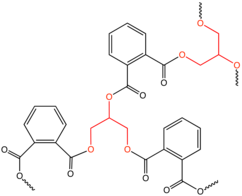Polyol
A polyol is an organic compound containing multiple hydroxyl groups. The term "polyol" can have slightly different meanings depending on whether it is being used in the field of food science or that of polymer chemistry. A molecule with more than two hydroxyl groups is a polyol, with three – a triol, and with four – a tetrol. By convention, polyols do not refer to compounds that contain other functional groups.
Classification
Low molecular weight polyols
| Examples for low molecular weight polyols |
Pentaerythritol |
 |
Sugar alcohols
Sugar alcohols, a class of polyols, are commonly obtained by hydrogenation of sugars. They have the formula (CHOH)nH2, where n = 4–6.[1]
Sugar alcohols are added to foods because of their lower caloric content than sugars; however, they are also, in general, less sweet, and are often combined with high-intensity sweeteners. They are also added to chewing gum because they are not broken down by bacteria in the mouth or metabolized to acids, and thus do not contribute to tooth decay. Maltitol, sorbitol, xylitol, erythritol, and isomalt are common sugar alcohols.
Polymeric polyols
| Examples for polymeric polyols |
 polyether polyol (The oxygen atoms of the ether groups are shown in blue.) |
 polyester polyol (The oxygen and carbon atoms of the ester groups are shown in blue.) |
The term polyol is used for a number of polyethers of polyols and polyesters ("polyether polyols" and "polyester polyols"). A typical example is polyethylene oxide or polyethylene glycol (PEG) and polypropylene glycol (PPG). Polyols are used, inter alia, as a monomer in combination with diisocyanates in the production of polyurethanes.
The term "polyol" is also attributed to polymers comprising a multitude of hydroxyl groups, e. g. polyvinyl alcohol has the formula (CH2CHOH)n, i.e. it has n alcohol groups where n can be in the thousands. Cellulose is a polymer with many alcohol groups, but it is usually not referred to as a polyol.
A distinction has to be made between polymeric compounds containing terminal hydroxyl groups (polyether polyols and polyester polyols) and polymeric compounds containing multiple hydroxyl groups (e. g. polyvinyl alcohol).
Use
Polymeric polyols
Polymeric polyols react with isocyanates to make polyurethanes, which find use to make mattresses, foam insulation for refrigerators and freezers, home and automotive seats, elastomeric shoe soles, fibers (e.g. Spandex), and adhesives.
Low molecular weight polyols

Low molecular weight polyols are widely used in polymer chemistry, where they function as crosslinking agents. Alkyd resins for example are used in paints and in moulds for casting. They are the dominant resin or "binder" in most commercial "oil-based" coatings. Approximately 200,000 tons of alkyd resins are produced each year. They are based on linking reactive monomers with through ester formation. Polyols used in the production of commercial alkyd resins are glycerol, trimethylolpropane, and pentaerythritol.[2]
Nanoscience
The preparation of metal nanoparticles often employ the "polyol method." In such cases, the polyol is usually a long chain diol such as hexadecanediol ((CH2)16(OH)2). Such diols serve as both reductants and surface-protecting agents for the nanoparticles.[3]
Properties
Since the generic term polyol is only derived from chemical nomenclature and just indicates the presence of several hydroxyl groups, no common properties can be assigned to all polyols. However, polyols are usually highly viscous (when polymeric) to solid (when low-molecular weight) at room temperature. This is due to the fact that hydrogen bonds are formed between the individual molecules.
See also
References
- Hubert Schiweck, Albert Bär, Roland Vogel, Eugen Schwarz, Markwart Kunz, Cécile Dusautois, Alexandre Clement, Caterine Lefranc, Bernd Lüssem, Matthias Moser, Siegfried Peters (2012). "Sugar Alcohols". Ullmann's Encyclopedia of Industrial Chemistry. Weinheim: Wiley-VCH. doi:10.1002/14356007.a25_413.pub3. ISBN 978-3527306732.CS1 maint: uses authors parameter (link)
- Frank N. Jones. "Alkyd Resins". Ullmann's Encyclopedia of Industrial Chemistry. Weinheim: Wiley-VCH. doi:10.1002/14356007.a01_409.
- Park, Jongnam; Joo, Jin; Kwon, Soon Gu; Jang, Youngjin; Hyeon, Taeghwan (2007). "Synthesis of monodisperse spherical nanocrystals". Angewandte Chemie International Edition. 46 (25): 4630–4660. doi:10.1002/anie.200603148. PMID 17525914.CS1 maint: uses authors parameter (link)
External links
